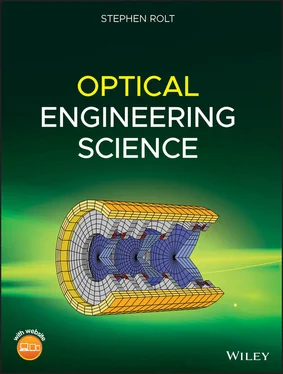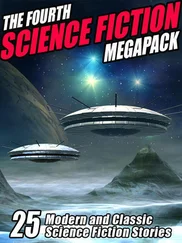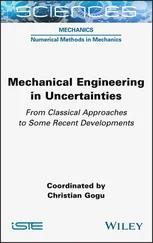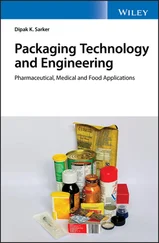10 Chapter 10Figure 10.1 Thin film reflectance at an interface.Figure 10.2 Performance of antireflection coating.Figure 10.3 Multilayer quarter wavelength stack.Figure 10.4 Multilayer stack – reflectivity vs wavelength (design wavelength 5...Figure 10.5 Transmission and reflection of a thin chromium film at 540 nm.Figure 10.6 Transmission of 4 nm chromium film vs. wavelength.Figure 10.7 Reflectivity of aluminium coatings.Figure 10.8 Performance of typical broadband antireflection coating.Figure 10.9 General characteristics of edge filters.Figure 10.10 Transmission of some WRATTEN™ filters.Figure 10.11 Bandpass filter characteristics.Figure 10.12 Typical characteristics of neutral density filters.Figure 10.13 Polarising beamsplitter.Figure 10.14 Polarising beam splitter (design wavelength 600 nm).Figure 10.15 Application of dichroic filter.Figure 10.16 Geometry of etalon filter.Figure 10.17 Etalon response function.Figure 10.18 Pressure tuned etalon.Figure 10.19 Basic bandpass filter design.Figure 10.20 Transmission for basic bandpass filter design.Figure 10.21 ‘Computer Optimised’ broadband antireflection coating performance...Figure 10.22 Evaporation process.Figure 10.23 Sputtering process.
11 Chapter 11Figure 11.1 Minimum deviation refraction produced by a prism.Figure 11.2 Anamorphic magnification by prism.Figure 11.3 Dual prism anamorphic magnifier.Figure 11.4 45° prism.Figure 11.5 Porro prism.Figure 11.6 Double Porro prism.Figure 11.7 Pentaprism.Figure 11.8 (a) Dove prism. (b) Abbe König prism.Figure 11.9 Corner cube retroreflector.Figure 11.10 Operation of diffraction grating.Figure 11.11 Diffraction pattern from grating with 10 slits.Figure 11.12 Diffraction efficiency vs order.Figure 11.13 Transmission grating.Figure 11.14 Phase grating efficiency.Figure 11.15 Diffraction for non-zero angle of incidence.Figure 11.16 Operation of reflective grating.Figure 11.17 Blazed diffraction grating.Figure 11.18 Diffraction grating in Littrow configuration.Figure 11.19 Generic efficiency curve for a blazed diffraction grating.Figure 11.20 Blazed grating showing polarisation orientations.Figure 11.21 Grating efficiency for two polarisation direc....Figure 11.22 Holographic grating profile.Figure 11.23 Echelle grating.Figure 11.24 Rowland grating arrangement.Figure 11.25 Grating prism or grism.Figure 11.26 Diffractive lens.Figure 11.27 Ruled grating replication.Figure 11.28 Fabrication of a holographic grating.
12 Chapter 12Figure 12.1 (a) Absorption. (b) Stimulated emission. (c) Spontaneous emission....Figure 12.2 Three level laser scheme.Figure 12.3 Schematic of Ruby laser.Figure 12.4 The helium neon pumping scheme.Figure 12.5 Helium neon laser.Figure 12.6 Stimulated emission in a semiconductor laser.Figure 12.7 Simplified sketch of semiconductor laser.Figure 12.8 Double heterostructure laser.Figure 12.9 Generalised representation of a laser cavity.Figure 12.10 Laser gain profile and longitudinal modes.Figure 12.11 Active mode locking.Figure 12.12 Q switched laser.Figure 12.13 Ring laser.Figure 12.14 Stable resonator geometry.Figure 12.15 Laser cavity stability.Figure 12.16 Gaussian beam and cavity geometry.Figure 12.17 Dye laser schematic.Figure 12.18 Parametric oscillator.Figure 12.19 Laser penetration depth vs. interaction time.Figure 12.20 Chart of laser materials processing applications.Figure 12.21 Laser tracking – 3D coordinate metrology.Figure 12.22 Quadrant detector.Figure 12.23 Underlying principle of holography.
13 Chapter 13Figure 13.1 Fibre propagation.Figure 13.2 (a) Step index fibre, (b) Graded index fibre.Figure 13.3 Periodic propagation in a graded index fibre.Figure 13.4 Ray paths in a focusing GRIN lens.Figure 13.5 Impact of fibre bend radius.Figure 13.6 Geometry of fibre bending.Figure 13.7 Geometrical effect of fibre bending on numerical aperture ( n 0= 1....Figure 13.8 Slab waveguide.Figure 13.9 Slab waveguide (weakly guided).Figure 13.10 Modal chromaticity for example waveguide.Figure 13.11 Strongly guided waveguide.Figure 13.12 Optical fibre model.Figure 13.13 Flux distribution in single mode fibre.Figure 13.14 Dependence of U and W parameters on normalised frequency paramete...Figure 13.15 Gaussian beam size, w 0, vs, normalised frequency parameter, V .Figure 13.16 Silica fibre attenuation.Figure 13.17 Group velocity dispersion in silica.Figure 13.18 Coupling into a multimode fibre.Figure 13.19 Fibre coupling and offset beam.Figure 13.20 (a) Splitter, (b) Combiner, (c) Coupler.Figure 13.21 Polarisation maintaining fibre preform.Figure 13.22 Photonic crystal fibre cross section.Figure 13.23 Creation of fibre Bragg grating ...Figure 13.24 Optical fibre manufacture.
14 Chapter 14Figure 14.1 Photomultiplier tube.Figure 14.2 Sensitivity of some photocathode materials.Figure 14.3 Photo-emission and thermionic emission.Figure 14.4 Operational principle of p-n photodiode.Figure 14.5 Layout of p-i-n detector.Figure 14.6 Sensitivity of photodiode materials.Figure 14.7 Effect of bias voltage on photodiode current.Figure 14.8 Operation of an avalanche photodiode.Figure 14.9 Operation of a CCD device.Figure 14.10 Active pixel or CMOS detector.Figure 14.11 Photoconductive detector.Figure 14.12 Simple bolometer.Figure 14.13 Sensitivity of InSb detector vs background temperature.Figure 14.14 Equivalent circuit for Johnson noise.Figure 14.15 Equivalent read circuit for array detector pixel.Figure 14.16 Frequency dependence of pink noise.Figure 14.17 Optical measurement with optical chopper and lock-in amplifier.Figure 14.18 Image centroiding.Figure 14.19 MTF of pixelated detector illustrating Nyquist sampling.
15 Chapter 15Figure 15.1 Paraxial layout of eyepiece.Figure 15.2 Cardinal points of Ramsden and Huygens eyepieces.Figure 15.3 Layout of optimised Kellner design.Figure 15.4 Performance of modified Kellner eyepiece.Figure 15.5 Plössl eyepiece layout.Figure 15.6 Performance of Plössl eyepiece.Figure 15.7 Modified Nägler eyepiece.Figure 15.8 Performance of modified Nägler eyepiece.Figure 15.9 Simple ×10 microscope objective.Figure 15.10 Wavefront error performance of simple ×10...Figure 15.11 ×100 Microscope objective.Figure 15.12 (a) Newtonian layout. (b) Cassegrain layout. (c) Pupil obscuratio...Figure 15.13 Ritchey-Chrétien telescope.Figure 15.14 Three mirror anastigmat.Figure 15.15 Schmidt camera system (sag of adaptor plate greatly exaggerated)....Figure 15.16 Basic Gauss doublet.Figure 15.17 Performance of simple Gauss lens.Figure 15.18 Optimised modified Gauss lens.Figure 15.19 Modified double Gauss performance.Figure 15.20 MTF of compact double Gauss lens.Figure 15.21 General layout of a zoom lens.Figure 15.22 Paraxial analysis of zoom lens performance.Figure 15.23 Mechanically compensated zoom lens.Figure 15.24 Paraxial outline of optically compensated zoom lens.Figure 15.25 Paraxial behaviour of optically compensated zoom lens.
16 Chapter 16Figure 16.1 Basic principle of interferometry.Figure 16.2 Fizeau interferometer.Figure 16.3 Twyman-Green interferometer.Figure 16.4 Mach-Zehnder interferometer.Figure 16.5 Lateral shear interferometer.Figure 16.6 Mirau objective.Figure 16.7 Modelled white light fringes.Figure 16.8 White light interferogram of diamond machined Al surface.Figure 16.9 ‘Vibration Free’ interferometer.Figure 16.10 Absolute form measurement of reference sphere.Figure 16.11 The three flat test.Figure 16.12 Interferometric testing of a paraboloidal mirror.Figure 16.13 Oblate spheroid test.Figure 16.14 Ross null test.Figure 16.15 Computer generated hologram Fizeau test.Figure 16.16 Shack-Hartmann wavefront sensor.Figure 16.17 Deployment of Shack-Hartmann sensor.Figure 16.18 Foucault knife edge test.Figure 16.19 Fringe projection.Figure 16.20 Shadow Moiré technique.Figure 16.21 Scanning pentaprism test.Figure 16.22 Confocal microscopy.
17 Chapter 17Figure 17.1 General layout of a monochromator.Figure 17.2 General layout of a spectrometer.Figure 17.3 Czerny-Turner monochromator.Figure 17.4 Slit function for varying slit widths.Figure 17.5 Fastie-Ebert spectrometer.Figure 17.6 Offner spectrometer.Figure 17.7 Image of slit at detector.Figure 17.8 Layout of imaging spectrometer.Figure 17.9 Principle of image slicing.Figure 17.10 Operation of a push broom scanner.Figure 17.11 Cross dispersion in an Echelle grating spectrometer.Figure 17.12 Fourier transform spectrometer.Figure 17.13 Fourier transform spectrograph of two closely spaced lines.
Читать дальше











